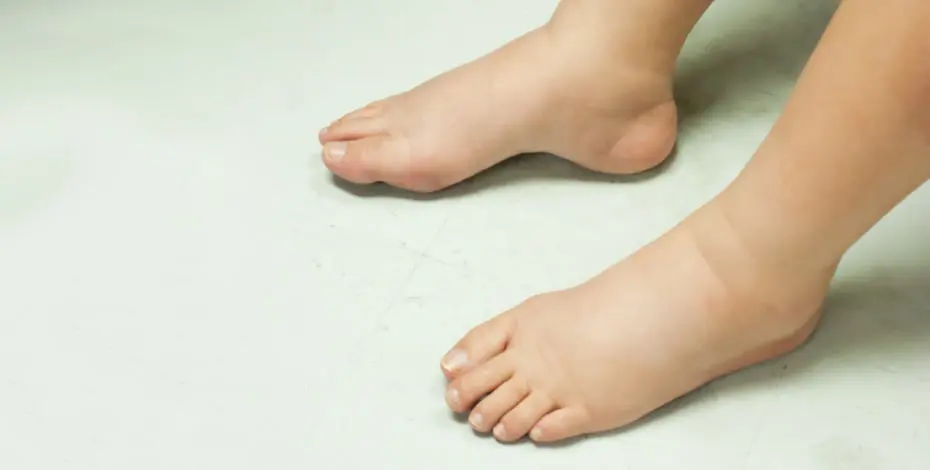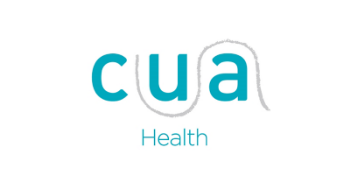Lymphoedema treatment Brisbane
Expert Lymphatic Drainage Massage combined with Pneumatic Compression Pumps can rapidly improve the pain and discomfort associated with Lymphoedema. Our scientifically validated methods help you manage lymphoedema swelling and/or recover from lymphoedema liposuction quickly.
At Knead Massage our qualified and experienced therapists can help you:
- manage your lymphoedema pain and swelling
- maintain skin integrity
- improve energy levels and movement quality
What is Lymphoedema?
Lymphoedema is defined as chronic swelling in the body.
Lymphoedema is caused by:
- Dysfunctional or damaged lymphatic vessels
- High blood pressure
- Absent lymph nodes (from surgery or injury).
Symptoms can be managed by competent lymphatic decongestive drainage massage and pneumatic compression pumps. Early intervention generally results in better outcomes.
Lymphoedema symptoms
Lymphoedema is classified as having 4 stages that usually affect the legs, arms and abdomen.
Stage 0. The area where you have lymphedema may feel tight or heavy, but it does not appear swollen. Some people do not have any symptoms at this stage.
Stage I. Sometimes there is swelling and a feeling of heaviness in the affected area. When you press it, it leaves a temporary dent in your skin. You may get relief by resting or lifting the affected arm or leg.
Stage II. The part of the body where you have lymphedema looks swollen most of the time and feels harder than the surrounding area. There are no dents when you press it. Resting and holding the limb does not help.
Stage III. The affected area looks very swollen and the skin feels thick and firm. You may lose some range of motion.
Can lymphedema be cured?
At present Lymphoedema can only be managed – not cured.
Management strategies involve Lymphoedema liposuction, pneumatic compression pumps, compression garments, complex manual drainage, movement strategies (such as hydrotherapy) and elevation of the affected limb.
Lymphedema causes
There are two definitions of lymphoedema:
- Primary lymphoedema caused by genetic characteristics inherited from your parents.
- Secondary lymphoedema is a consequence of an external condition such as:
- Cancer treatmentswhere lymphatic nodes are removed.
- Infections which cause the lymphatic vessels, and nodes to swell and become dysfunctional (fail to move lymph fluid).
- Inflammatory conditions like psoriasis and atopic eczema
- Venous diseases such as deep vein thrombosis, varicose veins, or venous insufficiency
- Carrying extra weight
- Trauma such as fracture and crush injuries
- Immobility (reduced movement or prolonged bedrest) may lead to lymphedema as lymphatic circulation requires movement to pump the fluid through the vessels.
Lymphedema Liposuction
- A specialist will determine whether you are a good candidate for lymphoedema liposuction.
- After surgery, manual lymphatic drainage recovery protocol will prevent the appearance of fibrosis (a permanent hardening of tissue) or seroma (swelling – serum pocket).
- Avoiding seroma and fibrosis with Lymphatic Massage is desirable as these conditions add complexity to lymphoedema management.
Liposuction can be effective at reducing swelling in stage 1 and 2 lymphoedema in some people. As previously mentioned, this is not a cure but combined with compression garments provide a meaningful reduction in swelling within 3-6months post operatively.
Lymphoedema treatment after liposuction should involve pneumatic compression pumps and complex decongestive drainage to improve lymph node efficiency and decrease oedema, fluid retention, and discomfort.
Start your journey toward relief with our specialised Lymphoedema Treatments
Lymphedema treatment Brisbane:
Lymphoedema Massage
Manual lymphatic drainage moves lymph fluid from the extremities to a central region of the body where lymphatic flow is not impaired.
Best Practice Guidelines in Assessment, Risk Reduction, Management, and Surveillance for Post-Breast Cancer Lymphedema https://www.ncbi.nlm.nih.gov/pmc/articles/PMC4523280/
Manual lymphatic drainage (MLD) is a therapeutic technique that involves the use of gentle, rhythmic movements with the hands to stimulate line flow through the lymphatic system
The primary effects of manual lymphatic drainage are to manage lymphatic dysfunction resulting in:
- Reduced swelling in limbs and face
- Improved immune functioning
- Optimised lymph flow
A typical stage 2 lymphoedema treatment frequency may respond to 3-4 sessions of decongestive drainage with compression pumps spaced over 4 weeks. The treatments will reduce swelling cumulatively and treatments will be spaced further apart.
Your therapist will also devise a home management care plan usually including:
- Showing you how to perform the lymph node opening sequence with the help of gloves or the brushing technique.
- Oedema reducing postures and exercises to maintain the effects of treatment
What is a compression pump?
Pneumatic compression pumps are devices that help move fluid out of an area of the body that has excess fluid. The pump applies light pressure starting at the furthest point out of the body and gently squeezes towards the centre of the body. This can be applied to any swollen area that is being treated. The benefits include:
- Softening of fibrosis or reducing pitting edema tissue texture (pitting is when the skin indents and stays indented with gentle pressure).
- Increases movement of lymphatic fluid and blood to reduce swelling.
- Improved wound healing.
Compression pump therapy offers an optimised management for managing acute chronic swelling – such as lymphoedema through:
- Fast relocation of excess lymph fluid from the limbs into the excretory organs (moving swelling associated with venous insufficiency and lymphoedema away from the swollen area into the gut and bladder to be evacuated).
- Greatly reducing inflammatory pain – reducing chronic swelling from the limb, reduces the inflammatory response of the body – meaning significantly less pain and discomfort.
- Improving venous return from the limbs to the heart. Reducing swelling and improving tissue quality allows blood flow to increase which has its own anti-inflammatory effects and improves energy levels and well-being.
- Skin integrity – swelling and chronic inflammation can compromise skin integrity leading to ulcers, pain and pathogens entering the body through wounds.
https://arbor.bfh.ch/5720/1/Therapy%20modalities%20to%20reduce%20lymphoedema%20in%20female%20breast%20cancer%20patients.pdf
Lymphedema Laser Therapy
Low level laser therapy (LLLT) or photobiomodulation (PBM) is a low intensity light therapy produced by laser or LED. When the light is applied over injuries or lesions a cellular response occurs which results in:
- improved tissue repair
- reduce inflammation
- a reduction in pain
The Laser and LED light stimulate the cells, (specifically a protein in mitochondria called cytochrome c oxidase), to increase ATP (cellular energy) production and reduce oxidative stress. This improves cell metabolism and speeds up healing in tissues.
Low level laser therapy/ Cold Laser Therapy aids in the treatment of lymphoedema by draining the swollen area which changes the inflammation from a painful form – to a more productive healing mode (improves cellular autophagy – tissue repair). It helps improve lymph flow throughout the lymph system and reduce excess fluid and protein built up in soft tissues.
Benefits of Low Level Laser for Lymphoedema:
- Improved recovery time
- Softening of hard fibrosis /scar tissue
- Reduction of swelling and inflammation
- Pain Relief that’s painless and often cured quickly
- Increased Joint mobility
At Knead Massage Brisbane, our experienced therapists provide focused hands-on care for all stages of Lymphoedema management. We incorporate expert complex decongestive drainage with proven pain free technology such as Low-Level Laser and Pneumatic Compression pumps to help maintain your quality of life and well-being.
FAQs
Arm compression sleeve for lymphedema
Lymphedema is chronic swelling caused by the lymphatic system’s inability to clear excess fluid. Treatment focuses on managing swelling, inflammation, and pain. The lymphatic system has no pump, relying instead on muscle movement, breathing, gravity, and compression.
Pneumatic compression pump therapy uses inflatable cuffs (e.g., arm sleeves) that inflate and deflate to move fluid.
Benefits of compression therapy
- Reduces swelling by moving excess fluid.
- Improves circulation, aiding oxygen delivery, nutrition, and waste removal.
- Relieves pain and discomfort.
- Supports tissue repair and softens hardened tissue.
- Prevents worsening of lymphedema and protects skin.
- Improves mobility and flexibility.
- Pumps can treat arms and legs at the same time.
Cellulitis and lymphedema
Cellulitis is a serious skin infection that often affects limbs with lymphedema. Untreated, it can require hospitalization.
Lymphedema is a chronic condition where the lymphatic system cannot drain protein-rich fluid, causing swelling. Because it has no pump, fluid movement depends on breathing, muscle contractions, compression, and gravity.
Why cellulitis is linked to lymphedema:
- Chronic swelling and inflammation weaken skin, raising ulcer and infection risk.
- Lymphedema is inherently inflammatory.
- In advanced stages, skin may harden, thicken, and develop fat deposits or wart-like growths, increasing vulnerability.
Preventing cellulitis through lymphedema management:
- Skin care: Regular care lowers infection risk.
- Early intervention: Prompt treatment prevents severe swelling and infections.
- Manual Lymphatic Drainage (MLD): Reduces swelling, pain, and fibrosis, but must not be used during active cellulitis, as it can worsen infection.
- Pneumatic compression pump therapy: Inflatable sleeves inflate and deflate to move lymph fluid. Pumps deliver a directional massage wave that reduces swelling, inflammation, and skin breakdown, lowering infection risk.
How to treat lymphoedema
Lymphedema is a chronic condition where the lymphatic system cannot drain excess fluid, causing swelling. There is no cure, so treatment focuses on long-term management of swelling, inflammation, and pain. Early intervention reduces complications.
Management strategies:
- Manual Lymphatic Drainage (MLD): Gentle massage that stimulates lymph flow, reduces swelling and pain, softens fibrotic tissue, and improves mobility.
- Pneumatic pumps use inflatable cuffs to apply rhythmic pressure, moving lymph fluid, reducing swelling and inflammation, improving circulation, and easing pain. Pumps with overlapping chambers prevent incorrect flow.
- Exercise: Low-impact activities (swimming, walking, yoga, cycling) stimulate muscle contractions that move lymph fluid. Water exercise adds natural compression.
- Skin Care: Vital for preventing infections like cellulitis, which can cause serious complications.
- Diet: A low-inflammatory diet is recommended, ideally with guidance from a lymphedema-trained dietitian.
- Adjunctive Therapies:
- Low-Level Laser Therapy (LLLT): Helps reduce swelling, pain, fibrosis, and improves mobility.
- Dry Brushing: Stimulates lymph flow, exfoliates, and boosts circulation, but should be avoided on damaged or sensitive skin.
- Surgery: Liposuction may reduce swelling in some Stage 1–2 cases but requires continued conservative care afterwards.
Lipedema vs lymphedema
Lymphodema is a long-term condition marked by persistent swelling due to the lymphatic system’s failure to adequately drain excess fluid, leading to fluid buildup. It may be primary (genetically inherited) or secondary (resulting from factors like trauma, infection, obesity, or surgical procedures). Typical signs include asymmetrical swelling, a sense of heaviness, skin thickening, tissue hardening (fibrosis), and general discomfort. The condition advances through four stages, ranging from mild puffiness to extensive fibrosis and tissue overgrowth. While incurable, treatment is centered on symptom management and includes Manual Lymphatic Drainage (MLD), compression therapy, physical activity, skin hygiene, and nutritional support. In earlier stages, liposuction may offer some benefit.
Lipedema, by contrast, is a disorder characterized by the abnormal accumulation of fat, primarily in the legs, buttocks, and occasionally the arms. It typically emerges during hormonal changes such as puberty or menopause, affects mostly women, and often has a genetic link. Key symptoms are symmetrical swelling, tenderness, easy bruising, fatigue, and fatty tissue that does not diminish with diet or exercise. The condition unfolds in three stages, beginning with small nodules and temporary swelling, eventually leading to extensive, hardened fat deposits. Although not curable, treatment focuses on pain relief and maintaining mobility, utilizing MLD, compression garments, exercise, and in later stages, liposuction—though this does not alter the visual appearance of the fatty tissue.
Lipoedema vs Lymphoedema
Lymphoedema is chronic swelling caused by the lymphatic system’s inability to drain excess fluid, leading to fluid buildup. It can be primary (congenital) or secondary (due to injury, infection, obesity, surgery, etc.). Symptoms include asymmetrical swelling, heaviness, skin thickening, fibrosis, and pain. It progresses through 4 stages, from mild swelling to severe fibrosis and growths. Management focuses on symptom control with Manual Lymphatic Drainage (MLD), compression therapy, exercise, skin care, and diet. No cure exists, but liposuction may be used for early stages.
Lipoedema is characterized by abnormal fat accumulation (mostly in legs, buttocks, arms), often during hormonal changes like puberty or menopause. It mainly affects women and is typically hereditary. Symptoms include symmetrical swelling, pain, bruising, fatigue, and fat that doesn’t respond to exercise or diet. There are 3 stages, from small nodules and reversible swelling to severe fat deposits. Treatment aims to manage pain and maintain function, using MLD, compression, exercise, and liposuction for advanced stages, though the appearance of fat doesn’t improve.
Key Distinguishing Features Summarized:
|
Feature |
Lymphoedema |
Lipoedema |
|
Causes |
Damage/dysfunction of lymphatic system (genetic, surgery, infection, trauma, high blood pressure, immobility) |
Abnormal fat accumulation (hormonal link, hereditary, exact cause unknown) |
|
Swelling Symmetry |
Often asymmetrical (one limb more affected) |
Always symmetrical (both sides equally affected) |
|
Hands/Feet Affected? |
Can affect hands and feet |
Does not affect hands and feet (stops abruptly at wrists/ankles) |
|
Pain |
May cause pain and heaviness, especially in later stages |
Usually painful to touch, even with light pressure |
|
Response to Diet/Exercise |
Can be managed by reducing inflammation through diet/exercise |
Not responsive to diet or conventional exercise for fat reduction |
|
Tissue Characteristics |
Can exhibit pitting oedema and progress to hard, fibrotic tissue |
Characterized by soft, fatty tissue that may develop into small or walnut-sized nodules |
|
Bruising |
May bruise, but not a primary characteristic |
Bruises easily due to capillary fragility |
Both conditions benefit from manual lymphatic drainage, compression therapy, exercise, and a healthy diet, but the underlying pathology and specific focuses of treatment differ significantly. Accurate diagnosis is crucial for effective management
Lymphedema
Lymphedema is a chronic condition caused by the lymphatic system’s inability to drain lymph fluid, leading to tissue swelling. While incurable, it can be effectively managed with lymphatic drainage massage and compression therapy.
Types of Lymphedema
- Primary Lymphedema is hereditary, due to underdeveloped lymphatic structures.
- Secondary Lymphedema results from trauma (e.g., injury, infection, venous disease, obesity) and is often linked to cancer treatments involving lymph node removal, radiation, or surgery.
Causes
Lymphedema stems from impaired lymph circulation, which relies on movement and breathing. Contributing factors include:
- Damaged or missing lymph vessels/nodes (often from surgery or injury)
- High blood pressure
- Infections
- Inflammatory skin conditions (e.g., psoriasis, eczema)
- Venous disorders (e.g., DVT, varicose veins)
- Obesity
- Trauma
- Immobility
Early intervention is crucial to prevent progression and complications like cellulitis.
Management
- Manual Lymphatic Drainage (MLD): Gentle, rhythmic massage to stimulate lymph flow, reduce swelling, improve circulation, soften fibrotic tissue, and restore mobility. Treatment starts by opening drainage pathways (often at the neck/collarbone).
- Compression Therapy: Custom garments and pneumatic pumps help prevent fluid buildup, ease discomfort, improve circulation, support tissue repair, and slow progression.
Lymphedema and cellulitis
Lymphedema is a chronic condition where the lymphatic system can’t drain protein-rich fluid, causing swelling. Without a natural pump, lymph relies on breathing, muscle movement, compression, and gravity to flow.
Cellulitis is a serious skin infection common in lymphedematous limbs. If untreated, it can lead to hospitalization.
Why lymphedema raises cellulitis risk:
- Chronic swelling and inflammation weaken the skin, increasing the chance of infection.
- Lymphedema is naturally inflammatory.
- In advanced stages, skin may harden, thicken, and develop fat deposits or wart-like growths, making it more vulnerable.
Preventing cellulitis through lymphedema care:
- Skin care: Reduces infection risk.
- Early intervention: Helps prevent severe swelling and complications.
- Manual Lymphatic Drainage (MLD): Eases swelling and fibrosis, but must be avoided during active cellulitis.
- Pneumatic compression pumps: Gently move lymph with pressure waves, reducing swelling, inflammation, and skin breakdown.
Lymphedema and exercise
As the lymphatic system has no central pump, movement, muscle contraction, breathing, and manual stimulation are essential to circulate lymph fluid.
Exercise is a key part of lymphedema management, alongside compression therapy, manual lymphatic drainage (MLD), bandaging (CDT), diet, and skin care.
Exercise Benefits:
- Promotes lymph flow
- Reduces swelling and fluid buildup
- Lowers inflammation and joint pain
- Boosts immune function
- Improves mobility and comfort
Recommended Activities:
- Low-impact exercises like:
- Water walking or aqua aerobics (natural compression)
- Swimming, yoga, elliptical, or stationary cycling
- Start slow, progress gradually – ideally with professional guidance
- Wear compression garments during exercise
- Avoid high-impact or painful activities
Lymphedema and lipedema
Lymphoedema is chronic swelling resulting from the lymphatic system’s inability to clear excess fluid, causing fluid retention. It can be primary (genetic) or secondary (caused by injury, infection, obesity, surgery, etc.). Common symptoms include uneven swelling, heaviness, thickened skin, fibrosis, and discomfort. It progresses through 4 stages, from mild swelling to severe fibrosis and growths. Treatment focuses on managing symptoms with Manual Lymphatic Drainage (MLD), compression therapy, exercise, skin care, and diet. There is no cure, though liposuction may help in earlier stages.
Lipoedema involves abnormal fat buildup, mostly in the legs, buttocks, and sometimes the arms, often triggered by hormonal shifts like puberty or menopause. It primarily affects women and tends to run in families. Symptoms include symmetrical swelling, pain, bruising, fatigue, and fat that doesn’t respond to exercise or diet. It progresses through 3 stages, from small nodules and reversible swelling to severe fat deposits. Treatment aims to relieve pain and preserve function, with MLD, compression, exercise, and liposuction for advanced stages, though it doesn’t improve the appearance of the fat.
Lymphedema and massage
Manual Lymphatic Drainage (MLD) is a gentle, evidence-based massage technique recognized internationally as standard care for lymphedema. It involves light, rhythmic pressure to stimulate lymph flow, avoiding deep pressure that could compress superficial lymph vessels.
It reduces swelling, pain, and fibrotic tissue, improves mobility, and supports long-term limb health. Treatment begins by opening lymphatic pathways, usually near the neck, and may target specific areas or the whole body.
Book your expert Lymphatic Drainage here:
https://www.kneadworkmassage.com/brisbane-massage-online-bookings/
Lymphedema arm
Arm Lymphedema is classified as:
- Primary Lymphedema – a hereditary condition caused by underdeveloped lymphatic vessels, appearing at birth, puberty, or adulthood, often triggered by stress or trauma.
- Secondary Lymphedema – more common, caused by damage to lymph nodes or vessels from:
- Cancer treatments (surgery, chemo, radiation—especially post-breast cancer). MLD is commonly used post-lymphadenectomy to relieve swelling and pain.
- Trauma (injuries, infections).
- Immobility, as lymph flow relies on movement.
Asymmetrical swelling, usually in one arm or hand, is a key sign.
While incurable, lymphedema can be managed with conservative treatment, including Manual Lymphatic Drainage (MLD).
Manual Lymphatic Drainage
- A gentle, rhythmic massage that stimulates superficial lymph flow (2–3mm below the skin).
- Benefits: Reduces swelling, pain, fibrosis; improves mobility, tissue health, and immune function.
- Process: Starts by opening drainage pathways (usually near the neck); taught for home use.
- Post-surgery: Supports recovery after breast procedures (e.g., mastectomy, augmentation), easing swelling, pain, and scar tissue while preventing fibrosis or seroma.
Additional therapies may include:
- Pneumatic compression pumps to move fluid from the limb
- Compression garments or bandaging to prevent fluid buildup
Lymphedema cause
Lymphedema is chronic swelling caused by the lymphatic system’s failure to drain excess fluid. It can be primary (congenital) or secondary, resulting from factors like surgery, injury, infection, obesity, or immobility. Symptoms include asymmetrical swelling, heaviness, skin thickening, fibrosis, and pain, progressing through four stages from mild swelling to severe fibrosis and skin changes.
Though incurable, symptoms are managed with Manual Lymphatic Drainage (MLD), compression therapy, exercise, skin care, and diet.
Key Factors Contributing to Lymphedema
- Damage or removal of lymph nodes/vessels
- High blood pressure
- Infections and inflammatory skin conditions (e.g., eczema, psoriasis)
- Venous disorders (e.g., DVT, varicose veins)
- Obesity, trauma, and immobility
Early intervention is critical to prevent progression and complications like cellulitis.
Management
- MLD: Gentle, rhythmic massage to stimulate lymph flow, reduce swelling and fibrosis, improve circulation, and restore mobility. Treatment begins by opening drainage pathways near the neck or collarbone.
- Compression Therapy: Custom garments and pneumatic pumps prevent fluid buildup, ease discomfort, aid tissue repair, and slow disease progression.
Lymphedema causes
Lymphedema is chronic swelling caused by the lymphatic system’s inability to drain excess fluid.
It can be congenital (primary) or develop from surgery, injury, infection, obesity, or immobility (secondary). Symptoms include asymmetrical swelling, heaviness, skin thickening, fibrosis, and pain, progressing through four stages. While incurable, symptoms are managed with Manual Lymphatic Drainage (MLD), compression, exercise, skin care, and diet.
Causes include damage or removal of lymph nodes or vessels, high blood pressure, infections, inflammatory skin conditions (e.g., eczema, psoriasis), venous disorders, obesity, trauma, and immobility. Early treatment is vital to prevent progression and complications like cellulitis.
Management includes MLD, a gentle massage that stimulates lymph flow, reduces swelling and fibrosis, improves circulation, and restores mobility by first opening drainage pathways near the neck. Compression therapy with custom garments and pneumatic pumps prevents fluid buildup, relieves discomfort, aids tissue repair, and slows disease progression.
Lymphedema cellulitis
Lymphedema is a long-term condition where the lymphatic system fails to properly drain protein-rich fluid, resulting in swelling. Since the system lacks its own pump, lymph movement depends on breathing, muscle activity, compression, and gravity.
Cellulitis, a potentially serious skin infection, is frequently seen in limbs affected by lymphedema and can lead to hospitalization if not promptly treated.
Why Lymphedema Increases Cellulitis Risk
- Ongoing swelling and inflammation compromise skin integrity, making infections more likely.
- Lymphedema is inherently inflammatory.
- In advanced cases, skin becomes thickened, hardened, and may form fatty tissue or wart-like nodules—further heightening vulnerability.
Preventing Cellulitis with Proper Lymphedema Management
- Consistent skin care lowers the risk of infection.
- Timely treatment can prevent progression and reduce complications.
- Manual Lymphatic Drainage (MLD) helps manage swelling and fibrosis but should not be used during an active infection.
- Pneumatic compression pumps apply gentle, rhythmic pressure to move lymph, decreasing fluid buildup, inflammation, and skin damage.
Lymphedema clinic
Knead Massage Brisbane provide effective Lymphedema treatments.
Services include:
- Lymphatic Drainage Massage (MLD): A gentle, rhythmic technique that stimulates lymph flow, reduces swelling, and improves immune function. Therapists also teach clients self-lymphatic drainage for home care.
- Pneumatic Compression Pump Therapy: Uses rhythmic inflation and deflation to move lymph fluid, reduce swelling, alleviate pain, soften fibrotic tissue, and improve circulation.
- Low-Level Laser Therapy (LLLT): Uses low-intensity light to reduce inflammation, improve lymph flow, soften fibrosis, and support tissue repair.
- Comprehensive Decongestive Drainage: Reduces tissue volume, pain, and tightness while preventing complications like skin lesions.
- Post-Liposuction Care: Assists in recovery after liposuction for lymphedema to prevent fibrosis and improve lymphatic function.
Book here:
https://www.kneadworkmassage.com/brisbane-massage-online-bookings/
Lymphedema clinic near me
Knead Massage Brisbane frequently help people manage Lymphedema.
Services include:
- Lymphatic Drainage Massage (MLD): A gentle, rhythmic technique that stimulates lymph flow, reduces swelling, and improves immune function. Therapists also teach clients self-lymphatic drainage for home care.
- Pneumatic Compression Pump Therapy: Uses rhythmic inflation and deflation to move lymph fluid, reduce swelling, alleviate pain, soften fibrotic tissue, and improve circulation.
- Low-Level Laser Therapy (LLLT): Uses low-intensity light to reduce inflammation, improve lymph flow, soften fibrosis, and support tissue repair.
- Comprehensive Decongestive Drainage: Reduces tissue volume, pain, and tightness while preventing complications like skin lesions.
Book here:
https://www.kneadworkmassage.com/brisbane-massage-online-bookings/
Lymphedema definition
Lymphedema is a chronic condition where the lymphatic system fails to properly drain excess fluid, leading to the accumulation of protein-rich fluid in tissues. It is incurable, but symptoms can be managed. The condition is categorized into two types:
- Primary Lymphedema: A congenital condition where the lymphatic system doesn’t develop correctly. It can appear at birth, puberty, or adulthood, often triggered by stress or trauma.
- Secondary Lymphedema: More common, caused by external factors such as cancer treatments, surgery, trauma, infections, venous diseases, obesity, immobility, and some surgical procedures.
Symptoms of lymphedema include asymmetrical swelling (often in one limb), heaviness, tightness, pitting edema (early stages), skin thickening, fibrosis, pain, loss of mobility, and skin changes. The condition can impact comfort, quality of life, and daily activities.
Early intervention is crucial for preventing severe swelling and complications like cellulitis.
Lymphedema drainage massage
Knead Massage Brisbane offers qualified treatments for Lymphedema. Their services include:
- Lymphatic Drainage Massage (MLD): A gentle, rhythmic massage that stimulates lymph flow, reduces swelling, and boosts immune function.
- Pneumatic Compression Pump Therapy: uses rhythmic inflation and deflation to move lymph fluid, alleviate swelling and pain, soften fibrotic tissue, and enhance circulation – moving large amounts of swelling out of the body.
- Low-Level Laser Therapy (LLLT): Low-intensity light is used to reduce inflammation, enhance lymph flow, soften fibrosis, and promote tissue healing.
- Comprehensive Decongestive Drainage: Helps reduce tissue volume, pain, and tightness while preventing complications like skin lesions.
- Post-Liposuction Care: Provides support after liposuction for lymphedema, helping to prevent fibrosis and improve lymphatic function.
Book an appointment here:
https://www.kneadworkmassage.com/brisbane-massage-online-bookings/
Lymphedema drainage massage near me
If you are in the Brisbane CBD or central suburbs and looking for convenient, effective lymphedema massage – look no further than Knead Massage. Our highly qualified therapists use scientifically validated methods and technology to ensure effective management of lymphedema symptoms. We offer a range of treatments, including:
- Lymphatic Drainage Massage (MLD): A gentle, rhythmic massage that encourages lymph flow, reduces swelling, and boosts immune function.
- Pneumatic Compression Pump Therapy: Utilizes rhythmic inflation and deflation to move lymph fluid, reduce swelling and pain, soften fibrotic tissue, and improve circulation, helping to expel large amounts of swelling from the body.
- Low-Level Laser Therapy (LLLT): Low-intensity light therapy designed to decrease inflammation, promote lymph flow, soften fibrosis, and support tissue healing.
- Comprehensive Decongestive Drainage: Reduces tissue volume, alleviates pain and tightness, and prevents complications such as skin lesions.
- Post-Liposuction Care: Specialized care for lymphedema following liposuction, helping prevent fibrosis and improve lymphatic function.
Book an appointment here: https://www.kneadworkmassage.com/brisbane-massage-online-bookings/
Lymphedema in arm
Arm Lymphedema is divided into two types:
- Primary Lymphedema – A genetic condition where the lymphatic system is not fully developed.
• Secondary Lymphedema – Usually caused by damage to the lymph nodes or vessels: - Cancer treatments (surgery, chemo, radiation, especially after breast cancer). MLD is often used after lymph node removal to reduce swelling and pain.
- Trauma (injuries, infections).
- Lack of movement, since lymph flow depends on body movement.
Though it can’t be cured, lymphedema can be managed with treatments like Manual Lymphatic Drainage (MLD).
Manual Lymphatic Drainage
- A gentle, rhythmic massage that helps move lymph fluid just under the skin.
- Benefits: Reduces swelling, pain, and thickening of tissue; helps with mobility, tissue health, and immune function.
- Post-surgery: Helps with recovery after surgeries like mastectomy or breast augmentation, easing swelling, pain, and scar tissue while stopping further fluid buildup.
Other treatments may include:
- Pneumatic compression pumps to help move large amounts of fluid out of the swollen.
- Compression garments or bandages to stop fluid from building up.
Lymphedema in arms
Arm Lymphedema is categorized into two types:
- Primary Lymphedema – A genetic condition where the lymphatic system is underdeveloped from birth.
• Secondary Lymphedema – Typically caused by damage to the lymphatic vessels or nodes, such as: - Cancer treatments (surgery, chemo, radiation, especially after breast cancer). MLD is commonly used after lymph node removal to ease swelling and discomfort.
- Trauma (injuries, infections).
- Limited movement, as lymph flow depends on body motion.
While there is no cure for lymphedema, it can be managed effectively with treatments like Manual Lymphatic Drainage (MLD).
Manual Lymphatic Drainage
- A soft, rhythmic massage that helps to move lymph fluid beneath the skin.
- Benefits: Reduces swelling, pain, and fibrosis; enhances mobility, tissue health, and immune response.
- Post-surgery: Assists in recovery after surgeries such as mastectomies or breast augmentations, alleviating swelling, pain, and scar tissue, while preventing fluid buildup.
Additional treatments may include:
- Pneumatic compression pumps to remove excess fluid from the affected area.
- Compression garments or bandages to prevent further fluid accumulation.
Lymphedema in legs
Lymphedema can cause fluid buildup in the legs, which may spread to the abdomen if drainage techniques aren’t used. It affects the legs, arms, and abdomen. For early stage lymphedema, resting or elevating the limb can help.
Treatment
Managing leg lymphedema focuses on reducing swelling, pain, and maintaining skin health. Key treatments include:
- Manual Lymphatic Drainage (MLD): A gentle massage that improves lymph flow and reduces swelling.
- Low-Level Laser Therapy (LLLT): Reduces pain and inflammation, and promotes tissue healing.
- Pneumatic compression pumps can reduce fluid volumes substantially if operated by a qualified professional
In severe cases, a 90-minute lymphatic massage followed by compression therapy can aid fluid drainage. Early treatment is crucial to avoid complications like infections
Lymphedema in legs treatment
Conservative management of lymphedema centers around the reduction of swelling, alleviating pain, and maintaining skin health. Key treatments include:
- Manual Lymphatic Drainage (MLD): A gentle massage that improves lymph flow and reduces swelling. By opening congested lymph nodes, the therapist can effectively move the trapped fluid to less affected areas for drainage.
- Low-Level Laser Therapy (LLLT): Helps reduce pain, inflammation, and supports tissue healing.
- Pneumatic Compression Pumps: When operated by a qualified professional, these can significantly reduce fluid buildup.
In severe cases, a 90-minute lymphatic massage followed by compression therapy can help drain excess fluid. Early treatment is crucial to avoid complications like infections.
Lymphedema legs
Lymphedema can cause fluid to build up in the legs, and it can spread to the abdomen, leading to skin ruptures or ulcers if not treated. It usually affects the legs, arms, and abdomen. In the early stages, resting or lifting the affected limb can help.
Treatment
Managing leg lymphedema focuses on reducing swelling, pain, and keeping the skin healthy. Main treatments include:
- Manual Lymphatic Drainage (MLD): A gentle massage that helps move the lymph fluid and reduce swelling.
- Low-Level Laser Therapy (LLLT): Helps reduce pain and swelling and helps heal tissues.
- Pneumatic Compression Pumps: When used by a trained professional, these can remove a lot of extra fluid.
For severe cases, a 90-minute lymphatic massage followed by compression therapy can help get rid of the fluid. Getting treatment early is important to avoid problems like infections and skin damage.
Lymphedema legs treatment
Managing lymphedema focuses on reducing swelling, easing pain, and keeping the skin healthy. Main treatments include:
- Manual Lymphatic Drainage (MLD): A gentle massage that helps the lymph fluid flow better and reduces swelling. The therapist opens blocked lymph nodes, so they can move the fluid to areas where it can drain properly.
- Low-Level Laser Therapy (LLLT): This helps reduce pain, swelling, and helps tissues heal.
- Pneumatic Compression Pumps: These pumps, when used by a trained professional, can help get rid of extra fluid in the body.
In more serious cases, a 90-minute lymphatic massage followed by compression therapy can help get rid of extra fluid. Starting treatment early is very important to prevent problems like infections.
Lymphedema massage
Lymphedema massage (Manual Lymphatic Drainage, MLD) is a gentle technique to manage lymphedema, a condition where fluid builds up in the body. While there’s no cure, MLD helps reduce swelling, pain, and maintain healthy skin.
The Process of Lymphedema Massage:
- Consultation: The therapist reviews your symptoms and goals to create a personalized plan.
- Opening the Lymphatic System: The massage starts by opening the lymph nodes to help move fluid into the excretory organs. You’ll be taught to do this at home daily.
- The Massage: MLD uses slow, gentle movements with light pressure to move fluid from the affected area to central body regions. The massage should never be painful or cause bruising.
- Duration and Frequency: Sessions last 60-90 minutes, often with pneumatic compression pumps for moderate to severe leg lymphedema.
Benefits:
- Reduces swelling and pain by moving fluid away from the legs.
- Improves lymphatic flow and prevents fluid buildup.
- Increases mobility by reducing tissue tension and swelling.
- Softens fibrotic tissue, making the skin more flexible.
- Decreases the risk of ulceration
Additional Therapies:
- Compression Therapy: Pneumatic pumps help move large amounts of fluid out of the affected area.
- Low-Level Laser Therapy (LLLT): Reduces pain, swelling, and promotes healing.
- Dry Brushing: Stimulates lymph flow and reduces fluid buildup.
Early treatment is essential to prevent complications.
Lymphedema meaning
Lymphedema is a chronic condition where the body can’t drain excess fluid, causing swelling. While there’s no cure, treatment helps manage swelling, pain, and inflammation, and early treatment prevents complications such as skin ulcers and cellulitis.
Key management strategies include:
- Manual Lymphatic Drainage (MLD): A gentle massage that reduces swelling, pain, and softens tissue.
- Pneumatic Pumps: Inflatable cuffs that apply pressure to move fluid and reduce swelling.
- Exercise: Low-impact activities like walking, swimming, and yoga help move fluid.
- Skin Care: Important for preventing infections like cellulitis.
- Diet: A low-inflammatory diet, with guidance from a dietitian, can help.
- Other Therapies:
- Low-Level Laser Therapy (LLLT): Reduces swelling, pain, and stiffness.
- Dry Brushing: Boosts circulation and fluid movement, but avoid on sensitive skin.
- Surgery: Liposuction may reduce swelling in some cases, but ongoing care is needed after.
Lymphedema meaning
Lymphedema is a chronic condition where the body struggles to drain excess fluid, leading to swelling. Although there’s no cure, treatment aims to manage swelling, pain, and inflammation, and early intervention helps prevent issues like skin ulcers and cellulitis.
Treatments include:
- Manual Lymphatic Drainage (MLD): A gentle massage that moves the lymph fluid to the excretory organs which, eases pain, and softens hard tissue.
- Pneumatic Pumps: Devices with inflatable cuffs that apply pressure to help move large volumes of fluid and reduce swelling.
- Skin Care: Essential for avoiding infections like cellulitis.
Additional Therapies:
- Low-Level Laser Therapy (LLLT): Reduces swelling, pain, and stiffness.
- Dry Brushing: Stimulates circulation and fluid flow, but avoid on sensitive skin.
Lymphedema of the legs
Lymphedema management of the legs aims to minimize swelling, relieve discomfort, and maintain healthy skin. The primary treatment methods include:
- Manual Lymphatic Drainage (MLD): This is a light, therapeutic massage technique that promotes better movement of lymph fluid and helps reduce swelling. It involves clearing blocked lymph nodes to redirect fluid to areas where it can drain more effectively.
- Low-Level Laser Therapy (LLLT): Used to ease pain, decrease swelling, and support tissue repair.
- Pneumatic Compression Pumps: When administered by a qualified professional, these pumps assist in removing excess fluid from the body.
In more advanced cases, a 90-minute lymphatic massage followed by compression therapy may be effective in flushing out fluid buildup. Early intervention is crucial to avoid complications such as infections.
Lymphedema or lipedema
Lymphedema is long-term swelling caused by a malfunctioning lymphatic system that fails to drain fluid properly. It may be primary (genetic) or secondary (from surgery, infection, obesity, trauma, etc.). Symptoms include asymmetrical swelling, heaviness, skin thickening, fibrosis, and pain. It advances through four stages, from mild swelling to severe tissue changes. Treatment focuses on symptom relief using Manual Lymphatic Drainage (MLD), compression, exercise, skin care, and diet. While there’s no cure, liposuction may help in early stages and maintain skin integrity.
Lipedema involves abnormal fat buildup, typically in the legs, buttocks, and arms, often triggered by hormonal changes like puberty or menopause. It primarily affects women and is often hereditary. Key symptoms include symmetrical swelling, tenderness, easy bruising, fatigue, and fat resistant to diet or exercise. It progresses through three stages, from soft nodules to extensive fat deposits. Treatment aims to manage pain and maintain mobility, using MLD, compression, exercise, and liposuction in advanced cases—though the fat’s appearance may not improve.
Key Differences at a Glance
|
Feature |
Lymphedema |
Lipedema |
|
Cause |
Lymphatic dysfunction (genetic, surgical, traumatic, etc.) |
Abnormal fat accumulation (hormonal, genetic) |
|
Swelling Symmetry |
Often asymmetrical |
Always symmetrical |
|
Hands/Feet Affected |
Often includes hands and feet |
Excludes hands and feet; stops at ankles/wrists |
|
Pain |
Heaviness and pain, especially in later stages |
Tender to touch, even with light pressure |
|
Response to Diet/Exercise |
Can improve with inflammation-reducing diet/exercise |
Unaffected by diet or conventional exercise |
|
Tissue Feel |
Pitting edema; may harden over time |
Soft, nodular fat deposits |
|
Bruising |
Possible but not common |
Frequent due to fragile capillaries |
Both conditions benefit from MLD, compression therapy, exercise, and healthy lifestyle choices, but they require different treatment focuses. An accurate diagnosis is essential for effective care.
Lymphedema pump
A lymphatic compression pump is a medical device used to reduce swelling in the arms or legs caused by lymphedema, lipedema, post-surgical swelling, or fluid retention.
The device uses an air pump connected to inflatable sleeves worn on the swollen limb. These sleeves gently inflate and deflate in a rhythmic pattern, creating pulsing pressure that moves excess fluid toward the center of the body for excretion.
Pump therapy is typically paired with Manual Lymphatic Drainage (MLD)—a gentle massage performed to open the lymph nodes – facilitating more effective pumping of fluid.
After MLD, the client wears the compression sleeve for at least 30-minutes. The pump inflates and deflates in timed cycles (e.g., one minute on, one minute off), with pressure adjusted to suit the individual’s condition and comfort. After the cycle completes the lymph nodes will again be oped using MLD to optimize lymph fluid removal.
At Knead Massage Brisbane, we use the industry-leading Lympha Press pump.
Benefits of Compression Pumping
Compression pumps offer multiple benefits, especially for chronic swelling:
- Reduces Swelling: Effectively moves fluid out of the limb, especially helpful for pitting edema.
- Relieves Pain and Discomfort: Less pressure means reduced pain, tightness, and heaviness.
- Improves Circulation: Enhances lymph and blood flow, boosting tissue oxygenation, energy, and waste removal.
- Softens Hardened Tissue: Helps break down fibrosis—hardening that can develop over time.
- Supports Skin Health: Reduces the risk of wounds, ulcers, and infections linked to long-term swelling.
- Slows Progression: Early and regular use may stop conditions like lymphedema from worsening.
- Enhances Mobility: Less swelling and pain improve flexibility and ease of movement.
Lymphedema pump for legs
At Knead Massage Brisbane, we use the Lympha Press—a leading device designed to reduce swelling in the arms or legs caused by lymphedema, lipedema, fluid retention, or post-surgical swelling.
The system consists of an air pump attached to inflatable sleeves worn over the affected limb. These sleeves rhythmically inflate and deflate, creating a gentle pulsing pressure that pushes excess lymph fluid toward the body’s center, where it can be eliminated.
Compression pump therapy is most effective when combined with Manual Lymphatic Drainage (MLD). Our expert therapists will open the lymph nodes, helping clear the pathways for fluid drainage.
Following this, the client wears the compression sleeve for at least 30 minutes, while the pump cycles through inflation and deflation (e.g., one minute on, one minute off). The pressure is tailored to the individual’s needs for maximum comfort and effectiveness. To complete the session, MLD is repeated to enhance fluid removal.
Benefits
Compression pump therapy offers significant benefits, particularly for people dealing with chronic swelling conditions:
- Reduces Swelling by efficiently draining large volumes of fluid
- Eases Pain and Discomfort by relieving pressure and reducing tightness and heaviness
- Improves Circulation, while supporting lymph removal
- Softens Fibrotic Tissue, helping break down hardened areas
- Protects Skin Health, lowering the risk of infections, ulcers, or skin breakdown
- Slows the Progression of conditions like lymphedema when used regularly in early stages
- Boosts Mobility by decreasing swelling and discomfort, improving movement and flexibility
Lymphedema pumps
Managing chronic swelling in the limbs—whether from lymphedema, lipedema, post-surgical recovery, or fluid retention—can be significantly improved with the use of a lymphatic compression pump.
Compression pumps operate through inflatable sleeves that are worn on the affected arm or leg. They create a gentle, rhythmic pressure (inflating and deflating) in a controlled sequence. This pulsing motion stimulates lymph flow, helping move large volumes of fluid away from the limb and back toward the elimination organs.
In a professional setting first your therapist will open the lymph nodes to make pumping more effective. Manual Lymphatic Drainage (MLD)—a gentle, targeted massage technique performed by a trained therapist.
Once the nodes are opened, the pump will be applied. A typical cycle of inflation and deflation require 30-45 minutes (typically one minute on, one minute off). The pressure level is customized for each client and their circumstances. Manual drainage will be repeated after the pump cycle to support optimal drainage.
Compression pumps offer huge benefits for chronic swelling:
- Swelling Reduction: Effectively drains lymph fluid, particularly helpful in pitting edema
- Pain Relief: Reduces discomfort, tightness, and the sensation of heaviness
- Better Circulation: Boosts lymph and blood flow, improving tissue health and energy levels
- Fibrosis Softening: Helps break down hard, thickened tissue that may form over time
- Skin Protection: Maintains healthy skin by reducing the risk of breakdown, ulcers, and infections
- Disease Control: Regular use in early stages can slow or prevent the worsening of lymphedema
- Improved Mobility: Decreased swelling and discomfort lead to better movement and daily function
Lymphedema signs and symptoms
What Is Lymphedema?
Lymphedema is a long-term condition that causes swelling due to a buildup of lymph fluid when the lymphatic system is damaged or not working properly. It most commonly affects the arms, legs, or abdomen and gets worse over time if not treated.
Common Signs and Symptoms
- Swelling (Edema): The main symptom. It may reduce with limb elevation in early stages.
- Heaviness or Tightness: The limb may feel heavy or tight even before swelling appears.
- Pitting Edema: Pressing the swollen area may leave a dent, showing fluid buildup.
- Fibrosis: As swelling becomes long-term, the tissue may harden and thicken.
- Reduced Movement: Swelling can limit how well the limb moves.
- Skin Changes: In advanced stages, the skin may become thick, leathery, and develop wart-like growths. The risk of infections, ulcers, and wounds also increases.
- Pain or Discomfort: Caused by swelling and tissue changes.
Lymphedema vs. Lipedema
These conditions are often confused but are different:
|
Feature |
Lymphedema |
Lipedema |
|
Symmetry |
Usually affects one side |
Swelling is always symmetrical |
|
Location |
Can affect hands and feet |
Hands and feet are not affected |
|
Pain & Bruising |
May cause discomfort |
Painful to touch and bruises easily |
|
Tissue Feel |
Soft with pitting in early stage |
Fatty with small nodules under skin |
Stages
- Stage 0: No visible swelling, but the limb may feel tight or heavy.
- Stage 1: Swelling is soft and may go down with elevation. Pitting is common.
- Stage 2: Swelling becomes permanent. Tissue may harden, and elevation no longer helps.
- Stage 3: Severe swelling with thick, hard skin, wart-like growths, and a high risk of infection (e.g., cellulitis).
Early treatment is important to reduce symptoms, prevent complications (such as skin ulcers and cellulitis), and slow progression.
Lymphedema stages
Stages of Lymphedema
- Stage 0: No visible swelling, but the limb may feel tight or heavy.
- Stage 1: Swelling is soft and may go down with elevation. Pitting is common.
- Stage 2: Swelling becomes permanent. Tissue may harden, and elevation no longer helps.
- Stage 3: Severe swelling with thick, hard skin, wart-like growths, and a high risk of infection (e.g., cellulitis).
Early treatment is important to reduce symptoms, prevent complications (such as skin ulcers and cellulitis), and slow progression.
Lymphedema symptoms
Lymphedema is a chronic condition caused by a damaged or impaired lymphatic system, leading to a buildup of lymph fluid and persistent swelling, most often in the arms, legs, or abdomen. Without treatment, it gradually worsens risking skin integrity (ulcers and cellulitis).
Common Symptoms
- Swelling (Edema): The primary symptom; may reduce with elevation in early stages.
- Heaviness or Tightness: Often felt before visible swelling appears.
- Pitting Edema: Pressing the skin may leave a temporary dent, indicating fluid buildup.
- Fibrosis: Long-term swelling can harden and thicken the tissue.
- Limited Mobility: Swelling may restrict movement in the affected limb.
- Skin Changes: In advanced stages, skin becomes thick, leathery, and may develop growths; infection risk increases.
- Pain or Discomfort: Caused by fluid buildup and tissue changes.
Early treatment is key to managing symptoms and preventing complications.
Lymphedema therapist
One of the most effective ways to manage lymphedema is Manual Lymphatic Drainage (MLD). This gentle, hands-on technique helps reduce pain, swelling, and supports skin health, though it is not a cure.
- Assessment: A therapist reviews your symptoms and goals to create a personalized treatment plan.
- Lymph Activation: The session starts by stimulating lymph nodes to promote fluid drainage toward waste-eliminating organs. Patients are taught how to perform this step at home daily.
- Massage Technique: Slow, light-pressure strokes guide fluid from swollen areas to central parts of the body. The massage is almost never painful.
- Duration: Sessions last 60–90 minutes. Pneumatic compression may be added for moderate to severe leg lymphedema.
Benefits:
- Reduces leg swelling and pain
- Improves lymphatic flow and prevents fluid buildup
- Enhances mobility by easing tissue tightness
- Softens fibrotic tissue and improves skin flexibility
- Lowers the risk of skin ulcers
Additional Therapies:
- Compression Pumps: Help move large volumes of fluid out of affected areas
- Low-Level Laser Therapy (LLLT): Reduces pain, swelling, and promotes healing
- Dry Brushing: Stimulates lymph flow and helps prevent fluid retention
Early treatment is key to avoiding complications and maintaining long-term relief.
Lymphedema therapy
Manual Lymphatic Drainage (MLD) is one of the most effective approaches for managing lymphedema. While it does not offer a cure, this gentle, hands-on therapy plays a key role in reducing swelling and discomfort, and in supporting overall skin health.
The process typically begins with a comprehensive assessment, where a trained therapist evaluates your symptoms and treatment goals. Based on this, they design a personalized care plan tailored to your needs.
The first step in each MLD session is lymph node activation. By stimulating key lymphatic areas, the therapist encourages the drainage of fluid toward organs responsible for waste elimination. Patients are also instructed on how to perform this technique daily at home to maintain results.
Next, the therapist applies a specialized massage technique using slow, gentle strokes. These movements help guide lymphatic fluid from congested areas toward the body’s central drainage pathways. The massage is designed to be comfortable and typically causes no pain.
Each MLD session usually lasts between 60 and 90 minutes. For individuals with moderate to severe swelling in the legs, pneumatic compression may also be incorporated to enhance results.
Key Benefits of MLD:
- Alleviates swelling and pain, particularly in the legs
- Boosts lymphatic circulation and prevents fluid buildup
- Enhances mobility by loosening tight tissues
- Softens hardened (fibrotic) areas and improves skin elasticity
- Reduces the risk of developing skin ulcers
To complement MLD, several additional therapies can further support lymphatic health:
- Compression Pumps: Aid in moving larger volumes of lymphatic fluid away from swollen regions
- Low-Level Laser Therapy (LLLT): Helps decrease inflammation and promote tissue repair
- Dry Brushing: Aids in stimulating lymph flow and reducing fluid retention
Starting treatment early is crucial for avoiding long-term complications and achieving lasting relief.
Lymphedema treatment
Manual Lymphatic Drainage (MLD) is a gentle, hands-on therapy that reduces the swelling and discomfort of lymphedema, and supports skin health reducing the risk of cellulitis and ulceration.
Treatment begins with an assessment and a care plan is constructed based on your symptoms and needs. Each session starts with lymph node opening to push fluid movement toward waste-elimination organs. Patients are often shown how to perform these techniques at home for maintenance.
Next, the therapist uses slow, rhythmic strokes to move lymph fluid from congested areas toward central drainage points. Sessions typically last 60–90 minutes, and for more severe swelling—especially in the legs—pneumatic compression may be added for enhanced results.
Benefits of MLD:
- Reduces swelling and pain (especially in the legs)
- Improves lymph flow and prevents fluid buildup
- Increases mobility by loosening tight tissue
- Softens fibrotic areas and improves skin elasticity
- Lowers risk of skin ulcers
Complementary Therapies:
- Compression Pumps – Move larger volumes of fluid
- Low-Level Laser Therapy (LLLT) – Reduces inflammation, promotes healing
- Dry Brushing – Stimulates lymph flow, minimizes fluid retention
Starting MLD early is key to avoiding long-term complications and achieving lasting relief.
Lymphedema treatment for legs
Lymphedema is abnormal fluid buildup that commonly causes swelling in the legs.
To manage symptoms, Manual Lymphatic Drainage (MLD)—a gentle massage technique—helps move lymph toward the body’s waste-removal centers, reducing swelling, relieving discomfort, and protecting the skin.
Pneumatic compression therapy, using inflatable sleeves that rhythmically inflate and deflate, is often used alongside MLD to enhance fluid movement. Low-Level Laser Therapy (LLLT) may also be added to reduce inflammation, relieve pain, and support tissue repair.
Benefits of Compression Therapy:
- Reduces swelling by moving excess fluid
- Improves circulation for better oxygen and waste removal
- Eases pain and discomfort
- Softens hardened tissue and supports healing
- Enhances skin mobility and flexibility
In more advanced cases, combining a 90-minute MLD session with compression therapy can significantly improve drainage and long-term relief.
Early treatment is key to avoiding complications such as infections and chronic tissue damage.
Lymphedema treatments
Lymphedema is the buildup of lymph fluid leading to\ swelling, discomfort, and an increased risk of skin issues such as cellulitis and ulceration.
Manual Lymphatic Drainage (MLD) is a key technique in management. MLD is a gentle, technique that moves lymph fluid toward the body’s waste-removal centers. This reduces swelling, relieves pain, improves mobility, and supports skin health.
How MLD Works
Treatment starts with an assessment and a tailored care plan. Each session begins with lymph node stimulation, followed by slow, rhythmic strokes that guide fluid from swollen areas to central drainage points. Sessions last 60–90 minutes, and patients are often shown self-care techniques to continue at home.
For advanced cases, combining a 90-minute MLD session with compression therapy enhances fluid movement and provides longer-lasting relief.
Pneumatic compression, using inflatable sleeves that gently inflate and deflate, is often combined with MLD to enhance fluid drainage.
- Reduces swelling and fluid buildup
- Improves circulation and waste removal
- Relieves pain and softens tissue
- Increases mobility and skin flexibility
- Prevents progression and skin damage
Complementary Therapies
- Low Level Laser: Reduces inflammation and promotes healing
- Dry Brushing: Stimulates lymph flow and minimizes fluid retention
Early intervention is key to preventing complications and maintaining long-term control. A combined approach using MLD, compression, and supportive therapies offers the best outcomes for managing lymphedema effectively.
Lymphedema vs lipedema
Lymphodema is chronic swelling caused by the lymphatic system’s inability to drain excess fluid. It can be primary (genetic) or secondary (due to surgery, injury, infection, or obesity). Symptoms include uneven swelling, heaviness, thickened skin, fibrosis, and discomfort. It progresses through four stages, from mild swelling to severe fibrosis and tissue overgrowth. Though incurable, symptoms are managed with Manual Lymphatic Drainage (MLD), compression, exercise, skin care, and diet. Liposuction may help in early stages.
Lipedema involves abnormal fat buildup, mainly in the legs, buttocks, and sometimes the arms, often triggered by hormonal changes like puberty or menopause. It primarily affects women and often runs in families. Symptoms include symmetrical swelling, pain, bruising, fatigue, and fat resistant to diet or exercise. It progresses through three stages, from soft nodules to hardened fat deposits. Treatment focuses on pain relief and mobility, using MLD, compression, exercise, and liposuction in advanced cases—though liposuction doesn’t improve fat appearance.
Lymphedema with cellulitis
Cellulitis is a serious skin infection that frequently occurs in limbs affected by lymphedema. If not treated promptly, it may lead to hospitalization.
Lymphedema is an incurable condition where the lymphatic system is unable to clear lymph fluid, resulting in swelling. Since the lymphatic system lacks a central pump, fluid movement relies on breathing, muscle activity, compression, and gravity.
Why cellulitis is associated with lymphedema:
- Persistent swelling and inflammation compromise the integrity of the skin, increasing the risk of ulcers and infections.
- Lymphedema itself causes ongoing inflammation.
- In advanced cases, the skin can become thickened, hardened, and develop fatty deposits or wart-like projections, making it more prone to infection.
Reducing cellulitis risk through lymphedema care:
- Skin maintenance: Routine skin hygiene helps prevent infections.
- Timely treatment: Early management can stop swelling and infections from worsening.
- Manual Lymphatic Drainage (MLD): This therapy alleviates swelling, discomfort, and tissue hardening but should be avoided during active cellulitis, as it can spread infection.
- Pneumatic compression therapy: These devices use inflatable sleeves that rhythmically compress the limb to move lymph fluid. This massage-like action helps decrease swelling, inflammation, and skin breakdown, reducing the risk of cellulitis.
Lymphoedema and cellulitis
Cellulitis is a serious bacterial skin infection that commonly affects limbs impacted by lymphoedema. Without timely treatment, it may progress and require hospitalization.
Lymphoedema is a chronic condition where the lymphatic system fails to drain protein-rich lymph fluid, leading to swelling. Because the lymphatic system has no internal pump, fluid movement relies on breathing, muscle activity, compression, and gravitational force.
How lymphoedema increases the risk of cellulitis:
- Long-term swelling and inflammation weaken the skin’s natural barrier, heightening the risk of ulcers and infection.
- Lymphoedema causes a constant state of inflammation.
- In more advanced stages, the skin may become thickened, hardened, and develop fatty build-up or wart-like skin changes, which further increase susceptibility to infection.
Preventing cellulitis through effective lymphoedema care:
- Consistent skin care: Helps maintain skin integrity and reduce infection risk.
- Early intervention: Addressing swelling promptly helps prevent complications, including cellulitis.
- Manual Lymphatic Drainage (MLD): A specialised technique that reduces swelling, pain, and fibrosis—but should be avoided during active cellulitis, as it may worsen the infection.
- Pneumatic compression therapy: Uses inflatable sleeves to gently move lymph fluid through rhythmic compression. This improves lymph flow, reduces swelling and skin breakdown, and lowers infection risk.
Lymphoedema and laser therapy
Lymphoedema is a chronic condition that causes swelling due to a malfunctioning lymphatic system, which fails to drain lymph fluid effectively. While there’s no cure, treatment focuses on managing swelling, pain, inflammation, and maintaining skin health to prevent infection.
Low-Level Laser Therapy (LLLT), or photobiomodulation (PBM), is a gentle light treatment using laser or LED devices, commonly used to help manage lymphoedema. LLLT is often combined with other treatments primarily Manual Lymphatic Drainage.
How It Works & Benefits:
LLLT stimulates cells by targeting mitochondria, boosting energy production (ATP) and reducing cellular stress. This improves cell function and speeds up healing.
For lymphoedema, LLLT may:
- Promote drainage by reducing painful inflammation
- Improve lymph flow
- Reduce fluid and protein buildup
- Soften scar tissue and fibrosis
- Decrease swelling and inflammation
- Provide fast, painless relief
- Improve joint mobility
- Accelerate recovery
At Knead Massage Brisbane, we integrate laser therapy with manual drainage and pneumatic compression to reduce symptoms, support skin health, and enhance movement and energy.
Lymphoedema and oedema
While both oedema and lymphoedema refer to swelling, they differ in cause and nature:
Lymphoedema:
Lymphoedema is a chronic swelling caused by a malfunctioning lymphatic system, which fails to drain lymph fluid.
Causes:
- Primary Lymphoedema: Hereditary or congenital, appearing at birth, puberty, or adulthood
- Secondary Lymphoedema: Acquired from:
- Trauma, infection, or surgery (especially lymph node removal)
- Radiation therapy
- Venous diseases
- Obesity, inflammation (e.g., eczema), or immobility
Oedema is a temporary or short-term swelling caused by fluid retention. Common causes include:
- Injury or illness
- High blood pressure
- Venous insufficiency
- Pregnancy-related fluid retention
- Lymphatic stress
- Conditions like DVT, heart/lung disease, or diabetes (Lymphaticd drainage is not the primary intervention for these conditions and will require doctors clearance first if you have them.)
Key Features of Lymphoedema that differentiate it from general oedema:
- Lymphoedema is a chronic condition.
- The swelling is due to fluid accumulation.
- Often presents as asymmetrical swelling, typically affecting one limb.
- Affected areas may experience thickened skin and a feeling of heaviness.
Lymphoedema arm
Arm lymphoedema typically presents as asymmetrical swelling in one arm or hand. Though incurable, it can be effectively managed with conservative therapies like Manual Lymphatic Drainage (MLD).
Types of Lymphoedema:
- Primary Lymphoedema: A hereditary condition caused by underdeveloped lymphatic vessels, appearing at birth, puberty, or adulthood, often triggered by stress or trauma.
- Secondary Lymphoedema (more common): Caused by damage to lymph nodes or vessels from:
- Cancer treatments (surgery, radiation, chemo—especially after breast cancer)
- Trauma or infection
- Immobility, which limits lymph flow
MLD is often used after lymph node removal to relieve swelling and discomfort.
Manual Lymphatic Drainage (MLD)
A light, rhythmic massage that stimulates lymph flow. It begins by clearing pathways near the neck, and the therapist manually moves fluid from the affected limb into the central lymph nodes, which are connected to the body’s excretory systems.
Benefits:
- Reduces swelling, pain, and fibrosis
- Improves mobility, tissue health, and immune function
- Aids post-breast surgery recovery (e.g., mastectomy, augmentation) by easing swelling, scar tissue, and preventing seroma or fibrosis
Other Therapies:
- Pneumatic compression pumps to move fluid out of the limb
- Compression garments or bandaging to maintain drainage and prevent buildup
Lymphoedema cause
Lymphoedema is a chronic swelling caused by the lymphatic system’s failure to drain excess fluid. It may be primary (congenital) or secondary, arising from surgery, injury, infection, obesity, or immobility.
Symptoms include asymmetrical swelling, heaviness, skin thickening, fibrosis, and pain, progressing through four stages. While incurable, early treatment is crucial to prevent complications like cellulitis.
Management combines therapies such as Manual Lymphatic Drainage (MLD)—a gentle massage that stimulates lymph flow by opening drainage pathways near the neck—reducing swelling, fibrosis, and discomfort while improving mobility. Compression garments and pneumatic pumps help prevent fluid buildup, ease symptoms, and promote tissue repair. Supporting care with exercise, skin care, and diet also aids symptom control.
Common causes include lymph node damage or removal, venous disorders, inflammatory skin conditions, high blood pressure, trauma, and immobility.
Lymphoedema causes
Lymphoedema is a long-term condition involving swelling due to the lymphatic system’s failure to properly drain excess fluid. This results in fluid buildup, typically in the limbs, and can worsen over time if not addressed.
There are two main types:
- Primary lymphoedema is congenital, often due to underdeveloped or malformed lymphatic vessels.
- Secondary lymphoedema develops later in life from factors such as surgery, trauma, infections, obesity, immobility, or lymph node removal.
Typical symptoms include asymmetrical swelling, a feeling of heaviness, skin thickening, pain, and fibrosis (hardening of tissues). The condition advances through four clinical stages, from mild swelling to severe, irreversible tissue changes. Although it cannot be cured, it can be successfully managed.
Early intervention is essential to slow progression and prevent complications such as cellulitis. Contributing factors may include venous disease, high blood pressure, inflammatory skin conditions (like eczema or psoriasis), and lack of movement.
Treatment typically involves a multifaceted approach. One key therapy is Manual Lymphatic Drainage (MLD)—a gentle, targeted massage that activates lymph flow. It starts by stimulating drainage areas near the neck, then works outward to move fluid away from congested areas. MLD reduces swelling, fibrosis, and discomfort while improving circulation and mobility.
Complementary therapies include compression treatment using custom-fitted garments or pneumatic pumps, which help prevent fluid accumulation, reduce pressure and pain, and support tissue healing. Exercise, skin care, and a supportive diet also play vital roles in maintaining lymphatic health and managing symptoms.
Lymphoedema clinic
Knead Massage & Natural Therapies provides high-quality, evidence-based lymphoedema management using expert techniques and advanced technologies. Early intervention leads to better outcomes, and symptoms can be effectively managed.
The clinic supports clients with:
- Pain and swelling management.
- Skin integrity maintenance.
- Enhanced energy and movement quality.
Treatment options include:
- Manual Lymphatic Drainage (MLD) / Decongestive Drainage: Gentle hand techniques stimulate lymph flow, reduce swelling, and support immune function by directing fluid to areas with proper drainage.
- Lymphatic Compression Pump Therapy: Inflatable cuffs apply rhythmic pressure to move lymph fluid efficiently. Sessions last around 30 minutes, easing pain, improving circulation, and supporting skin health.
- Combined Therapy: MLD is paired with pump therapy for enhanced fluid movement, especially effective for lymphoedema and lipoedema. Therapists open the lymph nodes before apply pumps.
- Home Management Plan: Patients receive personalized self-care routines, including lymph node stimulation techniques and posture/exercise guidance to sustain progress.
- Post-Liposuction Care: Post-surgical MLD helps prevent complications like fibrosis and seroma. Compression therapy is recommended to enhance lymph function and reduce swelling.
Lymphoedema clinic near me
Knead Massage & Natural Therapies offers high-quality, evidence-based lymphoedema care using advanced technologies and expert techniques. Early intervention improves outcomes and helps manage symptoms effectively.
The clinic supports clients in reducing pain and swelling, maintaining skin integrity, and enhancing energy and mobility.
Treatment options include:
- Manual Lymphatic Drainage (MLD): Gentle hand movements stimulate lymph flow, reduce swelling, and support immune function by directing fluid to areas with proper drainage.
- Lymphatic Compression Pump Therapy: Inflatable cuffs apply rhythmic pressure to move lymph fluid efficiently, easing pain, improving circulation, and supporting skin health.
- Combined Therapy: MLD is paired with pump therapy for more effective fluid movement, especially for lymphoedema and lipoedema. Therapists prepare the lymphatic system before pump use.
- Home Management Plans: Clients receive tailored self-care routines, including lymph node stimulation techniques and exercises to maintain treatment results.
- Post-Liposuction Care: Post-surgical MLD helps prevent complications like fibrosis and seroma. Compression therapy supports lymphatic recovery and reduces swelling.
Lymphoedema definition
Lymphoedema is a chronic condition involving the accumulation of protein-rich fluid due to an impaired lymphatic system, which fails to properly drain excess interstitial fluid. Normally, the lymphatic system maintains fluid balance and filters waste through lymph nodes. When disrupted, it leads to swelling, typically in limbs, but it can affect any part of the body.
There are two main types:
- Primary Lymphoedema – a hereditary condition caused by underdeveloped lymphatic vessels, which may appear at birth, puberty, or later in life, and can be triggered by stress or trauma.
- Secondary Lymphoedema – acquired due to damage or trauma to the lymphatic system, commonly from surgery, cancer treatment, infections, inflammatory skin conditions, venous diseases, obesity, immobility, or cosmetic procedures.
Lymphoedema progresses in four stages and is recognized as an inflammatory disease. Although it has no cure, early diagnosis and treatment are key to managing symptoms and preventing complications such as severe swelling and infections like cellulitis.
Lymphoedema in legs
Lymphedema often leads to fluid accumulation in the legs, and if left untreated with proper drainage techniques, the swelling can extend into the abdomen. It typically affects the legs, arms, and abdominal area. In its early stages, simple measures such as limb elevation or rest can help manage symptoms.
Treatment Overview:
The primary goals of managing leg lymphedema are to reduce swelling and pain while preserving skin health. Several effective treatment options are available:
- Manual Lymphatic Drainage (MLD): A gentle massage technique designed to stimulate lymph flow and decrease swelling.
- Low-Level Laser Therapy (LLLT): Helps reduce inflammation and pain, while supporting tissue repair and healing.
- Pneumatic Compression Pumps: When used by trained professionals, these devices can significantly reduce fluid buildup.
For more advanced cases, a combination of a 90-minute lymphatic massage followed by compression therapy can enhance drainage. Early intervention is advisable to decrease pain and prevent complications such as infections.
Lymphoedema leg pump
A lymphoedema leg pump—also called a pneumatic compression pump—is a medical device used to manage chronic limb swelling, especially in lymphoedema. It works by inflating and deflating cuffs worn on the affected limb, applying pressure to move excess lymph fluid into the bloodstream. Sessions typically last 30 minutes, with pressure tailored to the patient’s needs.
Key Benefits:
- Reduces swelling by moving excess fluid
- Decreases inflammation and pain
- Improves blood flow and energy
- Supports skin health, lowering infection risk
- Softens fibrotic tissue
- Enhances mobility and flexibility
- Slows progression of lymphoedema with regular use
Combination with MLD:
Pump therapy is often paired with Manual Lymphatic Drainage (MLD). Therapists first open and clear lymph nodes before using the pump to maximise drainage. This approach is also beneficial post-lymphoedema liposuction.
For stage 2 lymphoedema, 3–4 sessions over 4 weeks can reduce swelling, with longer intervals as symptoms improve. Pumps are also effective for home care, with therapists providing posture and exercise guidance to maintain results.
Pump therapy should be avoided or used cautiously in individuals with:
- DVT or blood clots
- Pulmonary embolism
- Heart or kidney disease
- Active infections or ulcers
- Conditions where increased fluid return is risky
Patients should wear loose, comfortable clothing (e.g., elastic-waist pants and socks) during sessions.
Knead Massage & Natural Therapies provides lymphatic compression pump therapy using premium LymphaPress devices, often combined with MLD for effective lymphoedema and lipoedema management.
Lymphoedema legs
Lymphedema commonly causes fluid buildup in the legs, and without management, swelling may increase – eventually progressing into the pelvic region. The most effective management strategies will involve manual lymphatic drainage massage.
Treatment Approaches:
Managing leg lymphedema focuses on alleviating swelling, relieving pain, and maintaining healthy skin. A variety of proven therapies are used depending on the severity of the condition:
- Manual Lymphatic Drainage (MLD): A light, rhythmical massage that encourages lymph flow and helps reduce fluid accumulation.
- Low-Level Laser Therapy (LLLT): A non-invasive technique that minimizes pain and inflammation while promoting tissue repair.
- Pneumatic Compression Pumps: These devices, when operated by trained professionals, can effectively move excess lymph fluid and reduce oedema.
In more severe cases, combining a 90-minute lymphatic massage with follow-up compression therapy can significantly improve drainage. Addressing lymphedema early is crucial to limit discomfort and lower the risk of secondary issues like infections.
Lymphoedema management
Lymphedema results from impaired lymph circulation, which depends on movement and lymph vessel capacity. Contributing factors include:
- Damaged or missing lymph vessels/nodes (often post-surgery or injury)
- High blood pressure
- Infections
- Inflammatory skin conditions (e.g., eczema, psoriasis)
- Venous disorders (e.g., DVT, varicose veins)
- Obesity
- Trauma
- Immobility
Managing leg lymphedema focuses on reducing swelling, relieving pain, and maintaining skin health. Treatment varies by severity and includes:
- Manual Lymphatic Drainage (International standard practice): Gentle, rhythmic massage to stimulate lymph flow, reduce swelling, soften tissue, and improve mobility. It begins by opening drainage pathways, usually at the neck.
- Compression Therapy: Custom garments or pneumatic pumps prevent fluid buildup, ease discomfort, support circulation, and slow progression.
Early treatment is key to minimizing symptoms and preventing complications like infection.
Lymphoedema massage
Manual Lymphatic Drainage (MLD) is a gentle, evidence-based massage technique that is internationally recognized as a standard treatment for lymphedema. This method uses light, rhythmic pressure to stimulate lymph flow while carefully avoiding deep pressure that might compress superficial lymph vessels.
MLD helps reduce swelling, pain, and fibrotic tissue, enhances mobility, and promotes long-term limb health. The treatment typically starts by opening lymphatic pathways, usually near the neck, and can focus on specific areas or the entire body.
Book your expert Lymphatic Drainage session here:
https://www.kneadworkmassage.com/brisbane-massage-online-bookings/
Lymphoedema meaning
Lymphoedema is a chronic condition caused by the lymphatic system’s inability to drain protein-rich fluid, leading to swelling—typically in the limbs. Normally, the lymphatic system maintains fluid balance and filters waste, but when impaired, fluid accumulates in tissues.
There are two types:
- Primary lymphoedema is genetic, resulting from underdeveloped lymph vessels. It may appear at birth, during puberty, or later in life, and can be triggered by trauma or stress.
- Secondary lymphoedema arises from damage to the lymphatic system due to surgery, cancer treatment, infections (e.g., filariasis), inflammatory skin conditions, venous diseases, obesity, immobility, or trauma, including cosmetic procedures.
Lymphoedema progresses in four stages and is classified as an inflammatory condition. While incurable, early intervention can effectively manage symptoms, reduce swelling, and prevent complications like cellulitis.
Lymphoedema pump
A lymphoedema pump (also called a pneumatic compression pump) helps manage lymphoedema and lipoedema by stimulating lymphatic drainage through rhythmic inflation and deflation of inflatable cuffs placed on affected limbs.
How It Works
- Uses a compression pump with garments that apply sequential pressure.
- Moves lymph fluid toward excretion pathways (e.g., bladder, bowel).
- Modern pumps feature overlapping chambers to prevent fluid backflow.
- Typical session: 30 minutes, with 1-minute inflate/deflate cycles.
- Pressure is adjusted to individual needs and comfort.
Key Benefits
- Reduces swelling (e.g., ~10% in lipoedema).
- Improves lymph drainage and circulation.
- Relieves pain, heaviness, and discomfort.
- Enhances mobility and skin health.
Combined Therapy
- Often used with Manual Lymphatic Drainage (MLD) for better results.
- Can treat multiple areas at once.
- Shown to be as effective as complex MLD in some cases.
Avoid if:
- DVT, pulmonary embolism
- Heart/kidney issues
- Infections, fever, ulcers
- Recent surgery (without clearance)
- Active/metastatic cancer (unless approved by oncology)
Other Notes
- Wear loose clothing; treatment should be comfortable.
- May increase urination or bowel movements as fluid clears.
Lymphoedema sleeve
A lymphoedema sleeve, also known as a pneumatic compression pump, is used to support lymphatic drainage and treat conditions like lymphoedema and lipoedema. It works by applying rhythmic compression to limbs through inflatable sleeves or garments.
Mechanism of Action
- The pump inflates and deflates sequentially, encouraging fluid movement.
- It directs excess lymph fluid toward organs responsible for elimination.
- Advanced models use overlapping chambers to maintain consistent flow and avoid backflow or banding.
- Typical sessions last about 30 minutes, with 1-minute cycles of compression and release.
- Pressure settings are personalized based on the user’s needs and tolerance.
Primary Advantages
- Helps reduce fluid retention and swelling (around 10% in lipoedema cases).
- Promotes effective lymphatic flow and better blood circulation.
- Eases pain, pressure, and heaviness in swollen areas.
- Improves mobility and supports skin integrity.
Use with Other Treatments
- Commonly paired with Manual Lymphatic Drainage (MLD) for enhanced results.
- Allows simultaneous treatment of different body parts.
- Research suggests it can match the effectiveness of full MLD therapy in some scenarios.
Contraindications
Pump therapy should not be used in cases involving:
- Blood clots (DVT), pulmonary embolism
- Heart or kidney disorders
- Infections, fever, or skin ulcers
- Recent surgeries (unless cleared by a doctor)
- Active or spreading cancer
Additional Information
- Loose-fitting clothes are recommended during use.
- Sessions should be comfortable, not painful.
- Increased urination or bowel activity is common afterward as fluids are expelled.
Lymphoedema stages
Lymphoedema is a progressive condition with no known cure, but early diagnosis and symptom management are key to reducing complications like infections and improving quality of life.
Importance of Early Intervention
- Early treatment helps control swelling, reduce discomfort, and prevent long-term damage.
- Good skin care, inflammation control, and pain management are essential throughout all stages.
Stages of Lymphoedema:
- Stage 0 (Subclinical/Latent Stage)
- No visible swelling yet.
- May feel heaviness or tightness.
- Some individuals are symptom-free.
- Stage I (Reversible Swelling)
- Swelling and heaviness present.
- Pitting oedema may occur (indentations when pressed).
- Swelling improves with rest or elevation.
- Stage II (Persistent Swelling and Tissue Changes)
- Constant swelling; tissue feels firm.
- Non-pitting oedema (no indentation when pressed).
- Swelling doesn’t reduce with rest.
- Fibrosis (tissue hardening) begins.
- Stage III (Severe and Irreversible Changes)
- Extensive swelling; skin is thick, firm, and leathery.
- Limited mobility in the affected area.
- Marked fibrosis, fat buildup, and wart-like skin changes.
Lymphoedema symptoms
Lymphoedema progresses through four stages:
Stage 1: Before any visible swelling, individuals may experience sensations of heaviness, tightness, or discomfort in the affected limb.
Stage 2: Fluid begins to accumulate; resulting in swelling that typically reduces when the limb is elevated. Pitting may be present.
Stage 3: Swelling becomes permanent and does not subside with elevation. Pitting and tissue hardening (fibrosis) may occur.
Stage 4: Swelling becomes severe. Pitting is no longer evident, but fibrosis is present. The skin may become hard and leathery, with fat accumulation and wart-like growths.
Once lymphoedema has progressed to these advanced stages without consistent management, quality of life is significantly worse as a result of fibrosis and pain. Early intervention in managing lymphoedema can greatly decrease symptom progression and reduce pain.
It’s important to note that not all swelling is caused by lymphoedema. If you experience unexplained swelling, consult your doctor to rule out other potential causes such as deep vein thrombosis, heart or lung conditions, or diabetes—among others that may lead to swelling.
Lymphoedema therapist
At Knead Massage Brisbane, we provide effective, evidence-based lymphoedema care. Our clinic offers a range of therapies designed to reduce swelling, support lymphatic function, and improve overall well-being.
Our services include:
• Comprehensive Decongestive Drainage: Designed to decrease pain, tightness, and tissue volume, this method also helps prevent complications such as skin breakdown or lesions.
• Low-Level Laser Therapy (LLLT): This non-invasive treatment uses light therapy to reduce inflammation, soften fibrotic tissue, encourage tissue repair, and improve lymph flow.
• Pneumatic Compression Pump Therapy: Involves cyclic inflation and deflation to stimulate lymph movement, relieve pain, reduce swelling, soften hardened tissue, and enhance blood flow.
• Post-Liposuction Recovery Support: Specifically for those undergoing liposuction for lymphoedema, this therapy aids recovery, minimises fibrosis risk, and promotes healthy lymphatic drainage.
If you’re seeking qualified support for lymphoedema, our team is here to help.
https://www.kneadworkmassage.com/brisbane-massage-online-bookings/
Massage for lymphoedema
Massage, especially Manual Lymphatic Drainage (MLD), is a key part of managing lymphoedema, a chronic condition caused by lymphatic system dysfunction leading to swelling. While there is no cure, treatment focuses on reducing symptoms like swelling, inflammation, and pain.
MLD is a gentle, evidence-based technique that promotes lymph flow and is central to best-practice lymphoedema care. It is often combined with other therapies, including:
- Pneumatic Compression Pump Therapy – applies rhythmic pressure to move lymph fluid, enhancing the effects of MLD.
- Low-Level Laser Therapy (LLLT) – reduces inflammation and fibrosis, improves healing, and promotes lymphatic drainage.
Benefits of MLD for lymphoedema include:
- Reduced swelling and pain
- Improved lymph flow and drainage
- Softening of fibrotic tissue
- Enhanced mobility and daily function
- Long-term symptom control when combined with other treatments
- Faster post-surgical recovery and scar management
Together, these therapies help manage lymphoedema effectively and improve quality of life.
Book here:
https://www.kneadworkmassage.com/brisbane-massage-online-bookings/
What does lymphedema pain feel like?
Lymphoedema doesn’t always start with visible swelling. For many—especially after limb trauma or cancer treatment—early signs may include pain, tightness, tingling, or heaviness. Early detection allows for conservative treatment that can slow or even prevent progression to more severe stages.
Early intervention helps:
- Control swelling before it becomes permanent
- Reduce discomfort and improve mobility
- Prevent tissue damage and complications
- Support skin health and lower infection risk
Focusing on skin care, inflammation, and pain management – is necessary throughout all stages.
Stages of Lymphoedema
- Stage 0 (Latent)
No visible swelling, but may feel heaviness or tightness. Some remain symptom-free. - Stage I (Reversible)
Swelling and pitting oedema appear; improves with rest or elevation. - Stage II (Persistent)
Constant swelling that no longer improves with elevation. Tissue becomes firm; fibrosis begins. - Stage III (Severe)
Permanent swelling with thick, leathery skin. Marked fibrosis, fat deposits, and wart-like changes may occur, often limiting mobility.
Related Posts
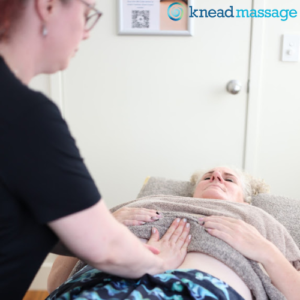
Lymphatic Drainage Massage Benefits
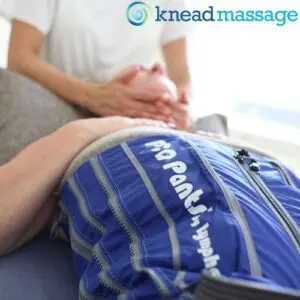
Lymphatic Compression Pump Therapy Brisbane
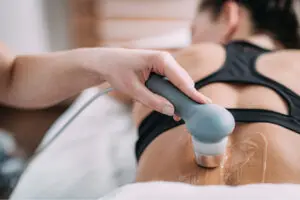
Low level laser therapy
https://www.betterhealth.vic.gov.au/health/conditionsandtreatments/lymphoedema
https://www.healthdirect.gov.au/lymphoedema
https://www.lymphoedema.org.au/
https://www.abc.net.au/health/minutes/stories/2001/06/25/319293.htm
https://abcnews.go.com/Health/OnCallPlus/story?id=3807427
https://www.youtube.com/watch?v=yHAx-AKXL0w
https://www.abc.net.au/news/2023-03-22/lipoedema-awareness-body-image-women-health/102093340
https://www.lymphoedema.org/information/what-is-lymphoedema/
https://www.lymphoedema.org/information/self-management-videos/
https://www.lakesidelaser.com.au/blog/low-level-cold-laser-therapys-effect-on-lymphedema
https://www.ncbi.nlm.nih.gov/pmc/articles/PMC4523280/
https://www.mdpi.com/2227-9032/11/18/2568
https://link.springer.com/article/10.1007/s11136-018-1796-5?fromPaywallRec=false
https://link.springer.com/article/10.1007/s11764-014-0411-1?fromPaywallRec=false
https://link.springer.com/article/10.1186/1471-2407-12-6
https://www.researchgate.net/profile/Ausanee-Wanchai/publication/256929563_Complementary_Alternative_and_Other_Non-Complete_Decongestive_Therapy_CDT_Treatment_Methods_in_the_Management_of_Lymphedema_A_Systematic_Search_and_Review/links/5ab387ba0f7e9b4897c638f7/Complementary-Alternative-and-Other-Non-Complete-Decongestive-Therapy-CDT-Treatment-Methods-in-the-Management-of-Lymphedema-A-Systematic-Search-and-Review.pdf?_sg%5B0%5D=started_experiment_milestone&origin=journalDetail&_rtd=e30%3D
https://www.ncbi.nlm.nih.gov/pmc/articles/PMC5951867/
https://web.archive.org/web/20181103224528id_/https://eprints.qut.edu.au/91461/3/91461.pdf
https://pubmed.ncbi.nlm.nih.gov/25741621/
https://www.ncbi.nlm.nih.gov/pmc/articles/PMC7950664/
https://www.awma.com.au/files/journal/2102_03.pdf
https://arbor.bfh.ch/5720/1/Therapy%20modalities%20to%20reduce%20lymphoedema%20in%20female%20breast%20cancer%20patients.pdf

Roger Morelli


Latest posts by Roger Morelli (see all)
- Lymphatic Drainage Facial Massage Brisbane - August 13th, 2025
- Lymphatic Drainage Massage Benefits - October 18th, 2024
- Lymphatic Compression Pump Therapy Brisbane - October 16th, 2024

